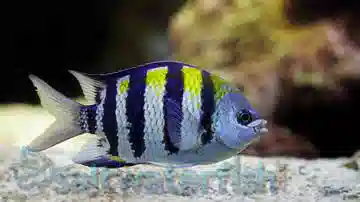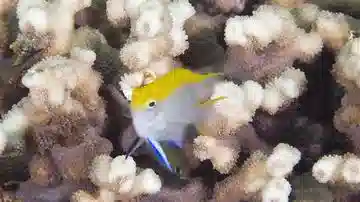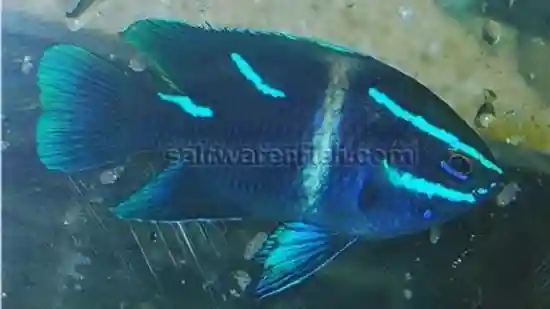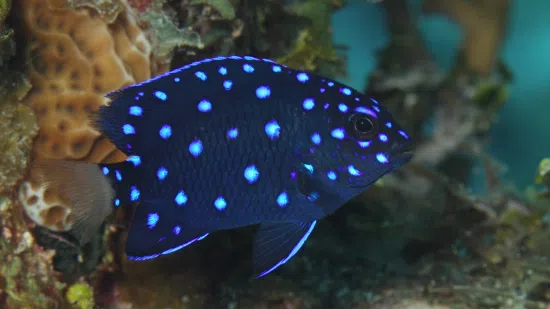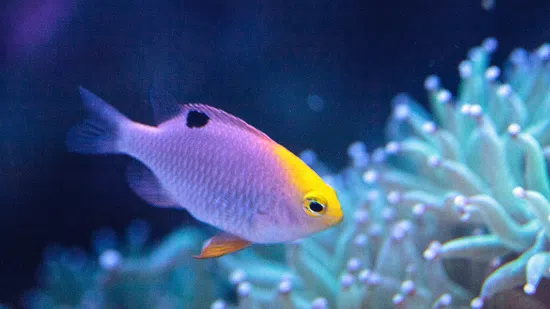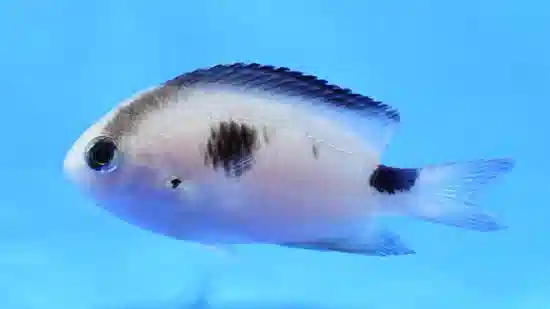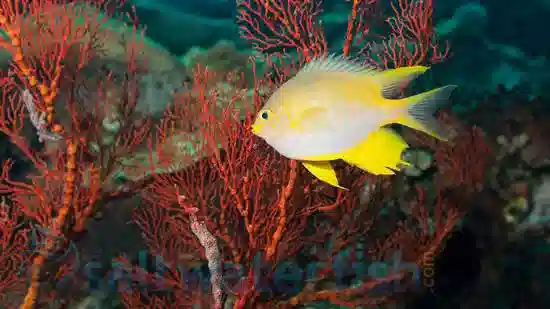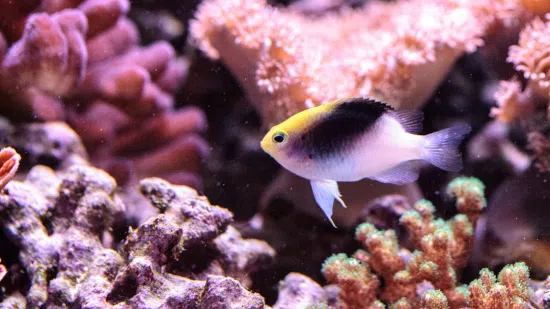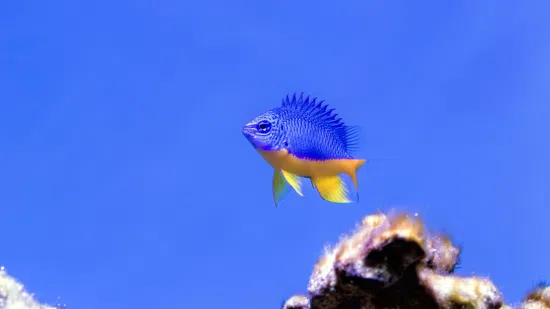Damsels In Saltwater Aquariums: FAQ
Damsels (Pomacentridae) are among the most widely available saltwater fish and often one of the first species new aquarists consider. Known for their hardiness, bright colors, and low cost, damsels can be an excellent choice, but their suitability depends on your tank setup and livestock goals.
Why damsels are good for many aquariums:
Incredibly hardy – They tolerate a wide range of water conditions, making them ideal for beginners still mastering marine chemistry.
Affordable and available – Damsels are some of the least expensive marine fish, available in vibrant blues, yellows, and two-tone patterns.
Active swimmers – They’re always on the move, adding life and energy to your aquarium.
Reef safe – Most damsels ignore corals and invertebrates, making them safe in reef aquariums.
Things to consider before adding damsels:
Aggression – Damsels are territorial and can become aggressive, especially in smaller tanks or when housed with peaceful fish.
Tank size – A larger aquarium (55+ gallons) with rockwork for hiding helps diffuse aggression.
Tankmates – They pair best with equally assertive fish (clownfish, wrasses, tangs), but may bully timid species like gobies or firefish.
Scientific studies confirm their resilience. A paper in Journal of Experimental Marine Biology and Ecology (2002) showed that damsels had higher survival rates under salinity and temperature stress compared to many other reef fishes. This makes them one of the toughest starter fish in the hobby.
One Saltwaterfish.com Yellowtail Blue Damsel buyer shared: “Great fish if you're looking for a splash of blue. VERY peaceful damselfish. He gets along with all his tank mates, including the Kupang Damselfish I added at the same time. Oftentimes he will swim with my two clowns.”* — Saltwaterfish.com Customer Review.
Bottom line: Damsels are hardy, colorful, and budget-friendly fish that do well in both reef and FOWLR aquariums. They’re best for aquarists who can manage their territorial behavior by providing space and compatible tankmates. For those looking for a tough, beginner-friendly marine fish, damsels remain a tried-and-true choice, backed by Saltwaterfish.com’s 8-Day Live Guarantee.
Damsels are known for their hardiness and adaptability, which makes them easier to acclimate than many saltwater fish. Still, proper acclimation is essential to reduce stress, prevent shock, and ensure long-term health. Whether you’re adding Blue Damsels, Yellowtail Damsels, or Domino Damsels, following a careful process will help them settle into your tank quickly.
Step-by-step acclimation process for damsels:
Float the bag – Place the sealed bag in your aquarium for 15–20 minutes to equalize temperature.
Drip acclimation – Transfer the damsels (and bag water) to a bucket. Using airline tubing, drip tank water into the bucket over 30–45 minutes until the water volume doubles. This gradually balances pH, salinity, and other parameters.
Dim the lights – Lowering aquarium lighting reduces stress during introduction.
Gentle transfer – Use a net to move the damsels into your tank—never pour store water directly into your system.
Provide hiding spots – Rockwork and caves help damsels feel secure during the first few days.
Because damsels are territorial, you’ll want to consider their introduction order. Adding them last, or adding several at once, can reduce aggression since no single fish has established dominance yet.
Schreck et al. (2001) found that marine fish exposed to stable acclimation conditions maintained lower cortisol levels and higher survival rates compared to those transferred abruptly.
One Saltwaterfish.com Javanese (Blue Velvet) Damsel buyer shared: “Only my second one of these ever, and gotta say, pretty fish. SWF does a great job of providing healthy fish with great color. At first I was a little weary of internet SWF, but this is my 3rd order and I’d say it’s done 100% right\!* — Saltwaterfish.com Customer Review.
Bottom line: Damsels are tough fish, but they benefit from slow drip acclimation, dim lighting, and proper transfer techniques. With the right start, they quickly adjust, begin eating, and establish themselves as colorful, active residents, backed by Saltwaterfish.com’s 8-Day Live Guarantee.
Damsels are hardy, opportunistic feeders, which makes them one of the easiest saltwater fish to feed in captivity. In the wild, they consume a varied diet of plankton, algae, and small invertebrates. In your aquarium, they’ll thrive on a similar mix of meaty foods and vegetable matter.
Best foods for damsels in captivity:
Frozen foods – mysis shrimp, enriched brine shrimp, finely chopped krill, and plankton
Pellets and flakes – high-quality marine formulas with added spirulina or garlic for immune support
Live foods (occasionally) – copepods, amphipods, or baby brine shrimp for enrichment and natural hunting behavior
Algae-based foods – sheets of nori or spirulina pellets help round out their diet and boost color
Feeding damsels is simple—they are aggressive eaters and will accept most foods right away. Offer small portions 1–2 times daily, ensuring all fish get a share. In community tanks, their boldness often means they eat first, so make sure more timid species aren’t outcompeted.
Wilson & Bellwood (1997) used stable isotope analysis to show that damselfishes thrive on a mix of plankton and algae in the wild, confirming that a diverse diet in aquariums promotes better coloration, health, and survival.
One Saltwaterfish.com Blue Devil Damsel buyer shared: “I've had Blue Devil Damsel for about a week and he's doing great. For the first few days I didn't see him at all, but now he makes appearances pecking at algae and darting in and out of the rocks and caves. Nice colors and appears healthy.” — Saltwaterfish.com Customer Review.
Bottom line: Damsels are undemanding, omnivorous feeders that adapt to nearly any prepared or frozen food. A balanced mix of protein and algae-based options ensures long-term health, vibrant color, and constant activity—backed by Saltwaterfish.com’s 8-Day Live Guarantee.
Damsels are among the hardiest and most affordable saltwater fish, making them excellent starter species for new aquarists. While nearly all damsels are resilient, some are more manageable for beginners thanks to their smaller adult size, attractive colors, and slightly milder temperaments. If you’re setting up your first reef or FOWLR (fish-only with live rock) system, these damsels are top beginner picks:
Yellowtail Damsel – A classic choice for new hobbyists. Bright blue body with a yellow tail, stays around 2–3 inches, reef safe, and among the least aggressive damsels.
Azure Damsel – Similar to the Yellowtail but with a more vivid color split; hardy, active, and slightly less territorial than other species.
Starck’s Damsel – Beautiful electric blue body with a bold yellow underside. Considered less aggressive than most damsels, especially in tanks with ample rockwork.
Why these damsels are beginner-friendly:
They’re extremely hardy, tolerating fluctuations in salinity and pH better than most marine fish.
They accept a wide variety of foods, from pellets to frozen mysis.
They adapt quickly, rarely hiding for long periods after introduction.
They’re reef safe, making them versatile for mixed setups.
One Saltwaterfish.com Kupang Damsel buyer shared: “Bought two and they are very active and have stunning colors.”* — Saltwaterfish.com Customer Review.
Bottom line: The best beginner damsels (Yellowtail, Azure, Starck’s) combine bright colors with unmatched hardiness. They’re perfect for first-time aquarists looking for durable, active, and reef-safe fish—backed by Saltwaterfish.com’s 8-Day Live Guarantee.
If you’re looking to add hardy, colorful damsels to your saltwater aquarium, buying from a trusted online source is essential. Not all retailers follow the same care, quarantine, or shipping standards, and poor sourcing can mean stressed or short-lived fish. For peace of mind, many aquarists turn to Saltwaterfish.com for healthy, guaranteed livestock.
Why buy damsels from Saltwaterfish.com?
Health Guarantee – Every fish is backed by the industry-leading 8-Day Live Guarantee, giving you confidence that your purchase will arrive healthy and adapt to your tank.
Wide selection – Choose from beginner-friendly species like the Yellowtail Damsel and Azure Damsel to bolder options like the Blue Devil Damsel or Domino Damsel.
Customer reviews – Hobbyists consistently highlight the quality of livestock. One Saltwaterfish.com Sergeant Major Damsel buyer shared: “Very nice reef fish. Sergeant Major Damsel cleans detritus in the live rock. Doesn't intrude on the reef. Easy keeper.”
Trusted reputation – With thousands of verified reviews and years of experience, Saltwaterfish.com is rated as a reliable source for marine livestock by beginner and advanced aquarists alike.
Bottom line: The safest place to buy healthy damsels online is a retailer with proven shipping practices, a strong health guarantee, and satisfied customers. Saltwaterfish.com delivers all three, ensuring your damsels arrive vibrant, hardy, and ready to thrive in your aquarium.
Yes, most damsels (such as Springer Damsel, Allen’s Damsel, and Fiji Devils) are reef safe and can be kept with shrimp, snails, and other invertebrates. Unlike larger predatory fish (such as triggers or non–reef safe wrasses), damsels don’t have the jaw strength or feeding instincts to hunt down snails or ornamental shrimp. Instead, they feed on plankton, algae, and prepared foods, leaving cleanup crew members alone.
Good news for reef keepers:
Shrimp safety – Cleaner shrimp, peppermint shrimp, and fire shrimp typically coexist peacefully with damsels.
Snails & hermits – Essential algae grazers like turbo snails, nassarius snails, and hermit crabs are safe with damsels.
Coral compatibility – Damsels won’t nip at corals, making them safe in mixed reef environments.
Considerations:
Tank size & aggression – Damsels can be territorial with other fish, but they generally ignore invertebrates. Keeping them in tanks 30+ gallons with hiding spots reduces stress for all tankmates.
Feeding balance – Since damsels are aggressive eaters, make sure food reaches bottom-dwelling invertebrates. Target feeding shrimp or offering sinking pellets helps.
Exceptions – While uncommon, larger, more aggressive damsels (like Domino Damsels) may occasionally chase small shrimp if space is tight, so provide rockwork for cover.
Wilson & Bellwood (1997) used stable isotope analysis to show that damselfishes thrive on a mix of plankton and algae in the wild, and are not typically invertebrate predators.
One Saltwaterfish.com Fiji Devil Damsel buyer shared: “A cute, little, lively Fiji Devil Damsel that brings a lot of character to your tank. Seems to play well with others and makes a welcome addition while being an easy keeper.” — Saltwaterfish.com Customer Review.
Bottom line: Damsels are reef safe and generally safe to keep with shrimp and snails. As long as your aquarium provides enough space and hiding spots, your cleanup crew will thrive alongside these hardy, colorful fish—backed by Saltwaterfish.com’s 8-Day Live Guarantee.
Damsel fish are hardy, colorful, and reef safe, but they also have a reputation for being territorial. Choosing the right tank mates is essential to prevent bullying and ensure long-term harmony. Most aquarists, hobbyists, and marine biologists agree that the best companions for damsels are equally hardy, semi-aggressive fish that can stand their ground without being overly aggressive themselves.
Best tank mates for damsels (consensus picks):
Clownfish (Amphiprion spp.) – Close relatives of damsels, they share similar temperaments and thrive together in reef tanks.
Wrasses (reef-safe species) – Fairy and flasher wrasses are peaceful, while six-line and melanurus wrasses are more assertive but still compatible.
Gobies & blennies – Peaceful bottom-dwellers that occupy a different niche, helping reduce territorial overlap.
*Chromis (Chromis viridis) – Schooling fish from the same family as damsels, but far less aggressive, providing visual balance and activity.
*Tangs (Zebrasoma, Acanthurus) – Active swimmers that hold their own without bothering damsels.
Dwarf angelfish (Centropyge species) – Coral Beauty, Flame, and other small angels are semi-aggressive enough to coexist.
Tank mates to avoid:
Very timid fish (firefish, dartfish, mandarins) may be chased and stressed.
Aggressive predators (groupers, lionfish, large triggers) may prey on damsels.
Multiple large Dascyllus damsels (Domino, Three-Stripe) together often fight bitterly unless housed in very large tanks.
One Saltwaterfish.com Three-Stripe Damsel buyer shared: “Very active and healthy. good for any tank.* — Saltwaterfish.com Customer Review.
Bottom line: The best tank mates for damsels are clownfish, wrasses, tangs, gobies, blennies, chromis, and dwarf angels. Fish that are hardy, semi-aggressive, or occupy different niches. Avoid very timid or very predatory species. With thoughtful selection and enough tank space, damsels can be part of a lively, balanced marine community, backed by Saltwaterfish.com’s 8-Day Live Guarantee.
Damsels are small (usually only 2–3 inches) but they punch above their weight when it comes to territorial behavior. Most aquarists agree that damsels rank as semi-aggressive fish, falling somewhere between peaceful species (like gobies and firefish) and truly aggressive predators (like triggers, groupers, or large wrasses).
Compared to other saltwater fish:
More aggressive than – Clownfish (though close relatives, clowns are usually less territorial), gobies, blennies, chromis, firefish, and cardinals. Damsels often chase these timid species if space is limited.
Similar aggression to – Six-line wrasses, dottybacks, and dwarf angelfish. These species can hold their own against damsels in medium-to-large tanks.
Less aggressive than – Triggers, large wrasses (e.g., Dragon or Banana), groupers, and puffers. These fish can overwhelm or even prey on damsels.
Aggression varies by species. Yellowtail and Azure Damsels are widely considered the least aggressive and very manageable in reef tanks. Domino and Three-Stripe Damsels (Dascyllus species), on the other hand, are notorious for becoming bullies as they mature, sometimes harassing fish many times their size.
Scientific studies confirm this territorial streak. Ceccarelli et al. (2001) showed that damselfishes aggressively defend algal feeding territories on coral reefs, often chasing away intruders many times their size, behavior that directly explains their semi-aggressive reputation in aquariums.
One Saltwaterfish.com Talbot’s Damsel buyer shared: “One of the most friendly of the Damsel species. Make sure you have him your tank first before adding extra Damsels. If your tank is big enough, you’ll have no worries. A very pretty color in the tank and will show in a reef tank.”* — Saltwaterfish.com Customer Review.
Bottom line: Damsels are semi-aggressive fish, tougher than peaceful reef species but less dangerous than true predators. Their aggression is manageable in larger aquariums (55+ gallons) with good aquascaping, and choosing milder species like Yellowtail or Azure keeps the community balanced—backed by Saltwaterfish.com’s 8-Day Live Guarantee.
Yes, while damsels are hardy enough to survive in bare setups, they thrive in aquariums with live rock. In the wild, damsels establish and defend small territories around reef structures, using crevices for shelter and algae growth for supplemental food. Re-creating that environment in your aquarium helps reduce stress, aggression, and improves their overall health.
Why live rock benefits damsels:
Shelter & territory – Damsels are territorial. Live rock allows them to claim spaces, reducing conflict between individuals.
Natural behavior – They dart in and out of crevices when startled, just like on a reef. Without hiding spots, they may become stressed or aggressive.
Supplemental feeding – Algae and microfauna that grow on live rock provide natural grazing opportunities, enriching their diet.
Water quality – Live rock boosts biological filtration, stabilizing water conditions—critical for beginner-friendly fish like damsels.
Holbrook & Schmitt (2002) demonstrated that habitat complexity directly influences damselfish survival, with access to shelter reducing stress and predation risk. In aquariums, live rock serves this same function, making it essential for long-term health.
One Saltwaterfish.com Springer Damsel buyer shared: “Nicely sized. Arrived healthy and acclimated easily. Really beautiful coloration. Seems well-behaved with the other fish in the tank. He is curiously exploring the tank and cautiously venturing out of the rockwork.” — Saltwaterfish.com Customer Review.
Bottom line: Damsels don’t strictly need live rock to survive, but they are healthier, less stressed, and more natural in tanks that provide it. For the best results, include plenty of live rock in your reef or FOWLR setup, giving your damsels shelter, territory, and stability, backed by Saltwaterfish.com’s 8-Day Live Guarantee.
Damsels are among the hardiest saltwater fish, but like all marine species, they can be vulnerable to common aquarium diseases, especially if stressed, overcrowded, or introduced without proper quarantine. Their small size and territorial behavior can mask early symptoms, so it’s important for aquarists to know what to watch for.
Common diseases in damsel fish include:
Marine Ich (Cryptocaryon irritans) – White cyst-like spots on the body and fins, rapid breathing, scratching on rocks. Very common in stressed new arrivals.
*Marine Velvet (Amyloodinium ocellatum) – Fine “dusty” coating, lethargy, and labored breathing. This parasite spreads quickly and can wipe out tanks if untreated.
Brooklynella (“Clownfish Disease” but affects damsels too) – Excessive mucus, rapid breathing, and skin sloughing. Often introduced on new fish.
Bacterial infections – Secondary to injury from fighting or poor water quality; symptoms include frayed fins, red sores, or cloudy eyes.
Internal parasites – Stringy white feces, loss of appetite, or wasting despite eating.
Prevention & treatment tips:
Quarantine new arrivals for 2–4 weeks to prevent introducing parasites.
Maintain stable water quality—fluctuations weaken immunity.
Feed a varied, vitamin-enriched diet (mysis, brine, spirulina-based flakes/pellets) to support immune health.
Treat promptly with copper-based medications for ich/velvet, formalin dips for brooklynella, and antibiotics for bacterial infections (always in a quarantine tank).
One Saltwaterfish.com 4 Stripe Damsel buyer shared: “Love this 4 Stripe Damsel\! He is so beautiful and such an interesting personality\! He doesn't bother anyone and has actually become friends with our yellow wrasse\! They swim attached at the hip looking for food\! He is a very mellow swimmer who loves swimming through the rock work to find new caves. He is a little hard to feed when competing with quicker eaters, I let a couple pellets sink in front of him and sink a few spirulina flakes\! I highly recommend him, he is sweet, beautiful, and easy\!” — Saltwaterfish.com Customer Review.
Bottom line: Damsels are hardy but can contract ich, velvet, brooklynella, bacterial, and parasitic infections under stress. With quarantine, stable water, and early intervention, these issues are highly manageable. helping your damsels remain the hardy, colorful fish they’re known for, backed by Saltwaterfish.com’s 8-Day Live Guarantee.
Damsels are small but territorial fish, so while they don’t need huge aquariums to survive, they need enough space to reduce aggression and maintain stable water quality. Most species stay between 2–3 inches, but their bold personalities mean they defend territories much larger than their size suggests.
General minimum tank requirements for damsels:
Single damsel – 20–30 gallons is sufficient for one damsel in a community tank.
Pair or small group (peaceful species) – 30–40 gallons with plenty of live rock for hiding and territory separation.
Aggressive species (Domino, Three-Stripe, Blue Devil) – 55+ gallons recommended, as larger tanks dilute aggression and give other fish room to escape.
Mixed community setups – 55–75 gallons or more if damsels are housed with tangs, angels, or wrasses.
Why tank size matters:
Territory control – In small tanks, damsels may dominate the entire space, bullying timid fish. Larger aquariums allow for natural spacing.
Water stability – Damsels are hardy but thrive best in stable water parameters, which are easier to maintain in bigger tanks.
Hiding spots – Rockwork and caves let damsels claim individual territories, reducing fighting.
One Saltwaterfish.com Jewel Damsel buyer shared: “I got a big surprise on this guy great color and very healthy was eating since day one\!”* — Saltwaterfish.com Customer Review.
Bottom line: While a single damsel can live in 20–30 gallons, most aquarists recommend 55+ gallons if you plan to keep multiple damsels or aggressive species. More space, rockwork, and hiding places ensure your damsels remain hardy, colorful, and enjoyable tankmates, backed by Saltwaterfish.com’s 8-Day Live Guarantee.
For decades, damselfish were the go-to species for cycling new saltwater aquariums because of their hardiness and low cost. They can survive the spikes in ammonia and nitrite that occur during the nitrogen cycle, but modern best practices (and the consensus among aquarists and marine biologists) now recommend fishless cycling instead. Here’s why:
Pros of using damsels for cycling:
Hardiness – Species like the Yellowtail Damsel and Azure Damsel can tolerate unstable conditions better than most saltwater fish.
Affordability – Damsels are inexpensive compared to other marine fish, making losses less financially devastating.
Activity & color – Even during cycling, damsels add visible movement and bright coloration to the tank.
Cons of using damsels for cycling:
Ethical concerns – Cycling with live fish exposes them to toxic ammonia and nitrite spikes, causing stress, organ damage, and shortened lifespans.
Aggression issues – Damsels added first often claim the entire tank as their territory, making it hard to introduce new fish later.
Better alternatives exist – Modern fishless cycling with bottled bacteria and ammonia is safer, faster, and avoids stressing livestock.
Randall & Tsui (2002) reviewed ammonia toxicity in marine fish and found that even hardy species exposed to cycling-level ammonia suffer long-term gill and osmoregulatory damage, underscoring why modern aquarists now recommend fishless cycling over using damsels.
One Saltwaterfish.com Golden Damsel buyer shared: “The Golden Damsel was shipped extremely well, and it was a perfect addition to my reef tank. I acclimated according to the instructions, and I have had no problems with any of the fish I have received. What more can you ask for? Cheaper then my local fish store and it was delivered to my front door the next day.” — Saltwaterfish.com Customer Review.
Bottom line: While damsels are hardy enough to survive tank cycling, most experts now recommend fishless cycling methods to avoid stressing fish and prevent long-term aggression problems. If you still choose to use damsels, stick with smaller, milder species like Yellowtail or Azure, and plan your future stocking carefully, backed by Saltwaterfish.com’s 8-Day Live Guarantee.
Chromis and damselfish often get grouped together because they both belong to the same family, Pomacentridae. However, aquarists, hobbyists, and marine biologists agree they behave very differently in aquariums and knowing the distinction helps you choose the right fish for your setup.
Key differences between Chromis and Damselfish:
Temperament – Chromis are widely considered peaceful, schooling fish that do well in groups. Damsels, while hardy, are territorial and can become aggressive toward tankmates, especially in smaller aquariums.
Schooling vs. territoriality – Chromis (like the popular Blue Green Reef Chromis) thrive in groups of 5–7 or more, creating beautiful schooling displays in open water. Damselfish, such as the Yellowtail Damsel, prefer to claim and defend a small territory within the rockwork.
Compatibility – Chromis mix easily with peaceful fish like gobies, clownfish, and wrasses. Damsels pair better with semi-aggressive species (clownfish, dwarf angelfish, tangs) that can hold their own.
Aggression scale – Chromis are on the lower end of the aggression spectrum, while many damselfish (Domino, Three-Stripe, Blue Devil) are on the higher end.
Use in aquariums – Chromis are chosen to add movement and activity to reef tanks, while damsels are often picked for their extreme hardiness, affordability, and bright coloration—especially by beginners.
One Saltwaterfish.com Beau Gregory Damsel buyer shared: “This is a great Beau Gregory Damsel who showed up healthy and happy. He was shy at first in my quarantine tank but after moving him over to the main tank he has been quite the showman. Beautiful fish to add to a reef tank.”* — Saltwaterfish.com Customer Review.
Bottom line: Chromis and damsels belong to the same family but differ in behavior. Chromis are peaceful schoolers ideal for community reef tanks, while damsels are hardy but territorial fish best kept with semi-aggressive tankmates. Both bring color and activity, but your choice depends on whether you want harmony in a school or the bold personality of a territorial fish—backed by Saltwaterfish.com’s 8-Day Live Guarantee.
Damsels have a reputation as some of the hardiest fish in the saltwater hobby—a big reason they’ve been used for decades as “starter fish.” According to expert consensus, the hardiest species are small Chrysiptera damsels, which tolerate fluctuations in water quality, eat a wide range of foods, and adapt easily to captivity.
Hardiest damsel fish species (consensus picks):
Yellowtail Damsel (Chrysiptera parasema) – Universally regarded as one of the toughest saltwater fish. Tolerates beginner mistakes, highly disease resistant, and remains relatively peaceful for a damsel.
*Azure Damsel (Chrysiptera hemicyanea) – Nearly as hardy as the Yellowtail, with a vivid two-tone blue and yellow coloration. Known to thrive even in less-than-perfect conditions.
*Domino Damsel (Dascyllus trimaculatus) – Extremely tough and long-lived, though far more aggressive. Hardy enough to survive harsh cycling conditions, but best suited for larger aquariums.
*Three-Stripe Damsel (Dascyllus aruanus) – Hardy and bold, often used in beginner tanks, but also quite territorial.
*Blue Devil Damsel (Chrysiptera cyanea) – Striking in color and very resilient, though prone to aggression as it matures.
Why these species are considered the hardiest:
They tolerate ammonia and nitrite spikes better than most marine fish.
They ship well compared to delicate reef fish.
They adapt to both pellet and frozen diets quickly.
They resist common diseases like ich more effectively than sensitive species.
One Saltwaterfish.com Orange Line Chromis buyer shared: “Beautiful little fish\!”* — Saltwaterfish.com Customer Review.
Bottom line: The hardiest damsels by consensus are Yellowtail, Azure, Domino, Three-Stripe, and Blue Devil. They are tough, adaptable, and long-lived, making them reliable starter fish. Just remember—while they’re nearly indestructible, some (like Domino and Blue Devil) can become aggressive, so plan your tankmates accordingly—backed by Saltwaterfish.com’s 8-Day Live Guarantee.
Damselfish are hardy and beautiful, but once established, they can become notoriously territorial. Many aquarists discover that removing an aggressive damsel (like a Four-Stripe or Neon Velvet) from a tank is much harder than expected. Because they’re small, fast, and dart into rockwork, catching them takes patience and strategy.
Proven methods for catching territorial damsels:
Use a fish trap – Commercial acrylic traps or DIY bottle traps baited with mysis shrimp or pellets are highly effective. Place the trap near the damsel’s territory and be patient—it may take a day or two.
Feed only in the trap – Damsels are greedy eaters. If you stop feeding the rest of the tank and only drop food into the trap, the damsel will eventually enter.
Net at night – After lights out, damsels often retreat into predictable crevices. With a red flashlight, you can gently net them while they’re less alert.
Remove rockwork temporarily – If other methods fail, dismantling part of the aquascape may be necessary to eliminate hiding places.
Divide and conquer – Using egg crate or acrylic dividers, you can corner the damsel into a smaller section of the tank and net it more easily.
Domenici (2002) showed that damselfish rely on rapid startle responses and darting into crevices as their primary predator-avoidance strategy, exactly the behavior that makes them so difficult to net in aquariums.
One Saltwaterfish.com Cross’s Damsel buyer shared: “I purchased 6 of these about a 7 weeks ago. All arrived healthy and eating the same day. Beautiful little fish, they do change color, not as bright as they mature. I lost one, the other five are a great addition to my reef system. They grow fast and seem to get along with everything.”* — Saltwaterfish.com Customer Review.
Bottom line: Catching a territorial damselfish requires patience and the right tools. Traps, nighttime netting, or temporarily rearranging rockwork are the most effective methods. With persistence, you can safely remove even the feistiest damsel—allowing the rest of your tank to thrive—backed by Saltwaterfish.com’s 8-Day Live Guarantee.
Damsels are known for their hardiness, bright colors, and budget-friendly price—but they also have a reputation for being territorial. Fortunately, not all damsels are aggressive. Some species are widely recognized by aquarists and marine biologists as peaceful enough for community reef aquariums, making them excellent choices for beginners and mixed setups.
Least aggressive damsels for reef tanks (consensus picks):
Yellowtail Damsel (Chrysiptera parasema) – Universally considered the calmest and most beginner-friendly damsel. Small (2–3 inches), hardy, and much less territorial than most species.
*Azure Damsel (Chrysiptera hemicyanea) – A two-tone blue and yellow damsel, nearly as peaceful as the Yellowtail, and a reliable reef-safe community fish.
*Starck’s Damsel (Chrysiptera starcki) – Electric blue with a golden belly; more assertive than Yellowtail or Azure, but far less aggressive than Dascyllus species.
*Talbot’s Damsel (Chrysiptera talboti) – Soft lavender body with a yellow face; one of the most peaceful damsels, though less commonly available.
*Springer’s Damsel (Chrysiptera springeri) – Deep blue with black highlights; considered one of the most docile Chrysiptera species, particularly in larger reef tanks.
Why these species work in reef tanks:
They stay small (2–3 inches), reducing the need for large territories.
They coexist well with peaceful reef fish such as gobies, clownfish, wrasses, and tangs.
They ignore corals, shrimp, and snails, making them fully reef safe.
One Saltwaterfish.com Pink Smith Damsel buyer shared: “I ordered 3 of these guys, they are bigger than I expected based on past purchases of similar fish. Not a bad thing. I am giving a 5 star because they are beautiful and exactly as described.” — Saltwaterfish.com Customer Review.
Bottom line: The least aggressive damsels for reef tanks are Yellowtail, Azure, Starck’s, Talbot’s, and Springer’s. These species combine the trademark hardiness of damsels with a calmer temperament, making them ideal for peaceful community reef aquariums—backed by Saltwaterfish.com’s 8-Day Live Guarantee.


